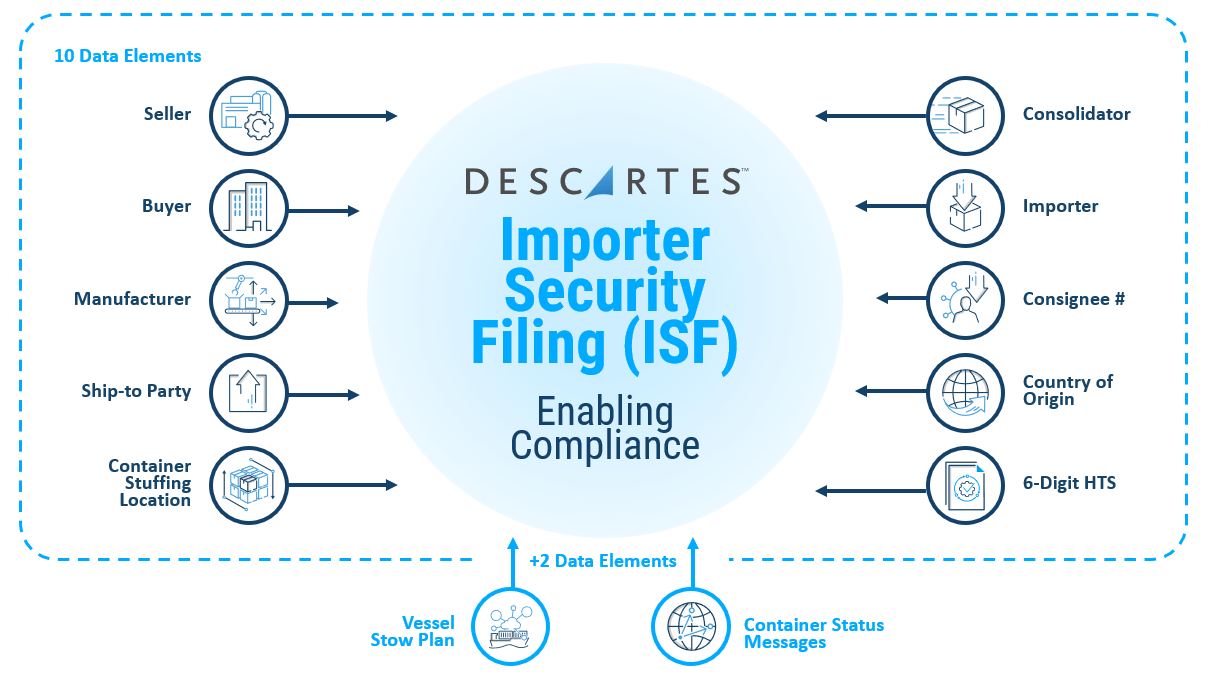U.S. Importer Security Filing (ISF) Resource Center
Updated Information on U.S. ISF Filing Advance Data Requirements for Ocean Shipments
This resource center includes information regarding the United States’ updated Importer Security Filing and Additional Carrier Requirements, commonly known as “ISF” or “10+2”, and how to file ISF with U.S. Customs and Border Protection (CBP)
What is the Importer Security Filing Program?
U.S. Customs and Border Protection (CBP) enacted the Importer Security Filing to help enhance security and pre-screen ocean cargo imported into the United States.
With enforcement now in full effect, it is more important than ever for filers to have the right technology in place to ensure compliance.
According to customs, ISF must be filed before merchandise arriving by vessel can be imported into the United States, importer or their agent must electronically submit certain advance cargo information to CBP. This requirement only applies to cargo arriving in the United States by ocean vessel.
What is an ISF and Why Was It Created?
An Importer Security Filing (ISF) is a document that importers must submit to U.S. Customs and Border Protection (CBP) before shipping cargo into the United States via ocean. The ISF is also known as "10+2" because it requires importers to provide 10 data elements and two documents from the carrier of goods. The ISF must be submitted electronically at least 24 hours before the shipment's departure. 10+2 was designed to enhance cargo security by requiring additional data elements prior to loading at the foreign port. Some of the additional reasons that ISF was created include the need to:
Who is responsible for filing ISF?
ISF 10+2 expands the responsibility of importers and adds accountability back to the point of container loading.
The ISF Importer is required to submit the Importer Security Filing. The ISF Importer is the party causing the goods to arrive within the limits of a port in the United States by vessel. Typically, the ISF Importer is the goods’ owner, purchaser, consignee, or agent such as a licensed customs broker.
However, for foreign cargo remaining on board (FROB), the ISF Importer is the carrier. For immediate exportation (IE) and transportation and exportation (T&E) in-bond shipments, and goods to be delivered to a foreign trade zone (FTZ), the ISF Importer is the party filing the IE, T&E, or FTZ documentation.
How to File ISF
In regard to how to file ISF, all filings need to be electronically submitted through either the Automated Broker Interface (ABI) or CBP's Automated Commercial Environment (ACE). Shippers will need to use a customs broker to file, or can self-file using an authorized ISF software provider.
Why is the Importer Security Filing (ISF) also called 10+2?
ISF is called 10+2 since there are 10 data items required from the importer or their agent, and 2 data elements required from the carrier.

To be fully ISF 10+2 compliant, the importer must supply:
Seller
Buyer
Manufacturer
Ship-to Party
Container stuffing location
Consolidator
Importer of record number/foreign trade zone applicant identification number
Consignee number(s)
Country of origin
Commodity Harmonized Tariff Schedule number to six (6) digits
The carrier must supply:
Container status messages
Ocean vessel stowage plan
What are the penalties associated with non-compliance?
CBP may issue liquidated damages of $5,000 per violation for the submission of an inaccurate, incomplete, or untimely filing. If goods for which an ISF has not been filed arrive in the U.S., CBP may withhold the release or transfer of the cargo; CBP may refuse to grant a permit to unlade for the merchandise; and if such cargo is unladen without permission, it may be subject to seizure. Additionally, noncompliant cargo could be subject to “do not load” orders at origin or further inspection on arrival.
How Descartes Can Help?
As a leading provider of customs compliance solutions Descartes helps organizations comply with ISF 10+2 compliance as well as other security filings worldwide.
